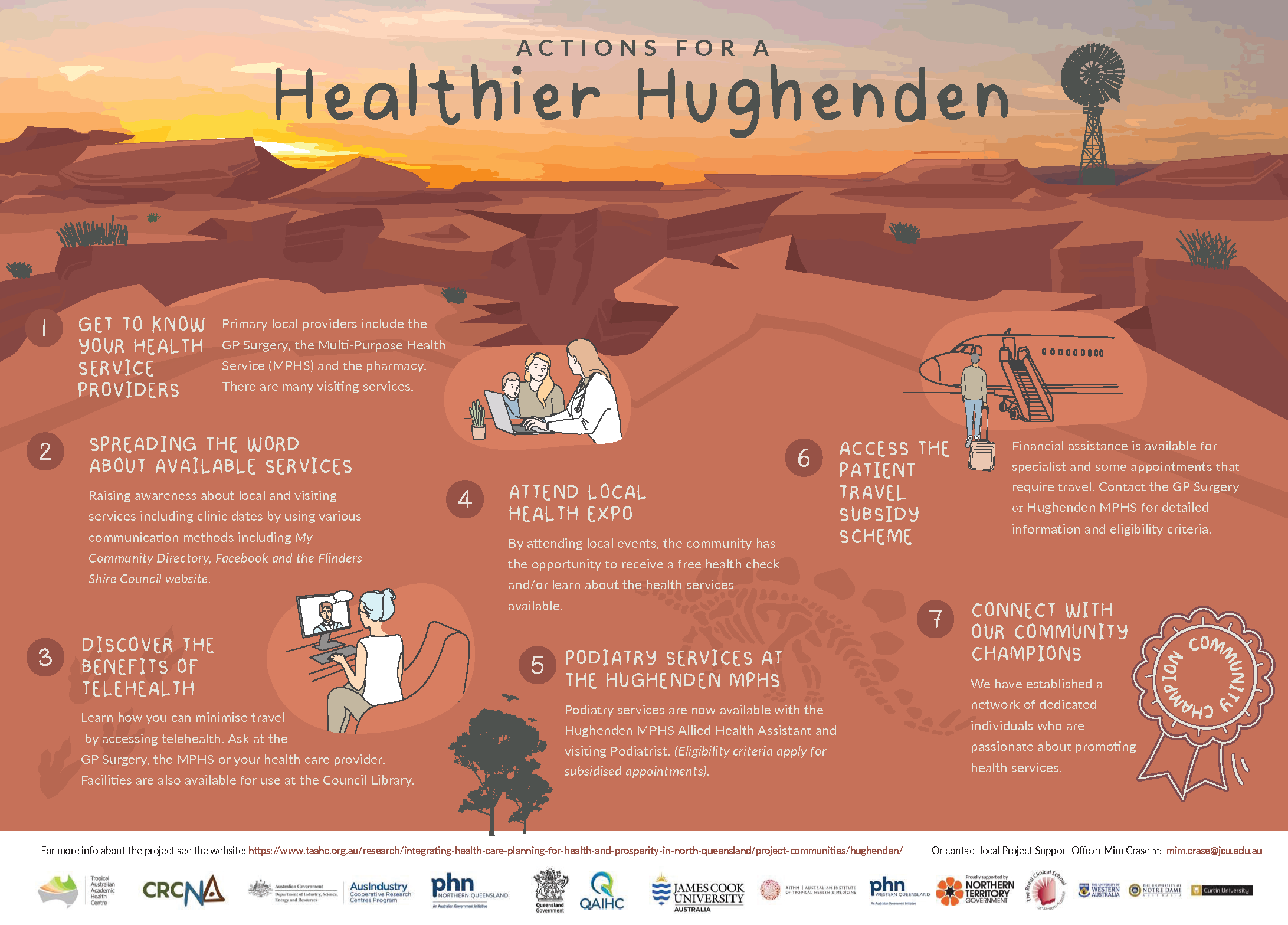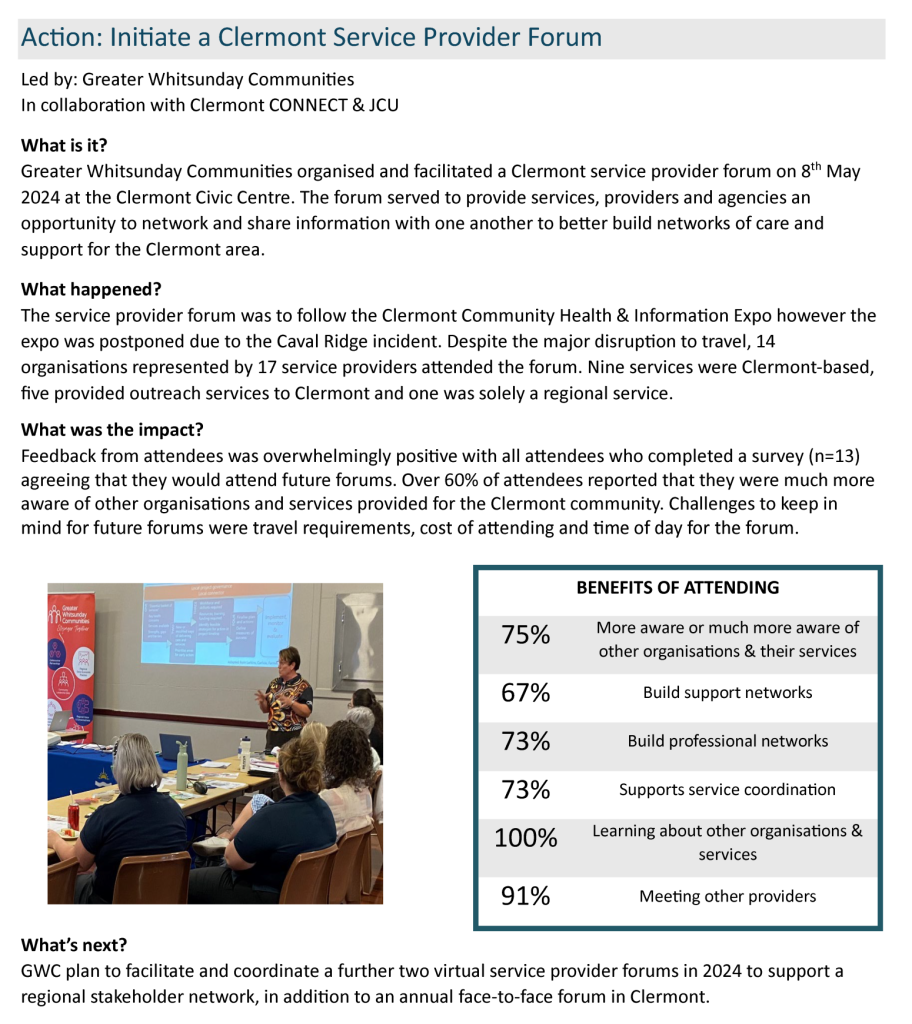Step 4. Implement actions, monitor, and evaluate changes
Implementing prioritised actions
Following the conclusion of the co-design process, prioritised action plans can be implemented by partners responsible for progressing or supporting the implementation of each action. The Local Connector can help drive and support partners to implement actions. Sub-committees or groups may be formed to work on particular actions.

Within the Clermont community, the Clermont Community Business Group who produced the monthly local newsletter, the Clermont Telegraph, took responsibility for promoting services, events and date claimers, including dates of visiting health professionals.
Figure 4.4.1 provides an example of a communication tool (flyer) used to update the Hughenden community on project progress and promote the actions prioritised for implementation. It was felt that the community preferred tools that used visuals and kept the words to a minimum. Adding a local touch to the design helped people connect with it and made it clear the work came from within the community. The Hughenden flyer featured a stylised image of Porcupine Gorge, a well-known local landmark and tourist spot, along with windmills, which are a common sight around town.

In Hughenden, refurbishments or the construction of a purpose-built health facility were important. Although not prioritised for action within the timeframe of the project, as it was assessed as a longer term, resource intensive action, the local Chamber of Commerce acknowledged this was an issue for which they could advocate. The availability of appropriate health facilities was an important factor in attracting workers and their families as part of local economic initiatives (Figure 4.4.2).

Communicating about actions and progress
Clear and regular communication with all stakeholders and the general community about actions prioritised for implementation, progress and outcomes will bring everyone along on the journey. Stakeholders appreciate seeing progress and tangible outcomes, even if they are incremental, as it reinforces the value of their contributions and engagement.
In all participating communities, regular project updates were provided to the local reference groups. In Hughenden and Clermont, where actions were implemented, updates were also published in the local newsletters and on social media.
Applying a research approach
As the place-based health planning project involved research, the action plans were converted into logic models. Logic models aim to clearly map out how a program is planned to work, defining the need or demand, activities to address these needs and anticipated outputs, short-term outcomes and long-term goals.

Appendix 9 – Logic model: provides an example of a logic model that was developed for work in the Clermont community.
Monitoring and evaluation
Progress on actions and associated activities should be reported back at local reference group meetings for monitoring purposes. The local reference group should review monitoring reports and provide oversight and guidance on any necessary adjustments to action implementation plans, including revising priorities and refining strategic directions.
It is important to evaluate both the process of co-design and health system redesign (including evaluation of each individual workshop) and the outcomes and impact of prioritised, identified actions or innovations.
Evaluation may comprise a combination of quantitative and qualitative methods. Quantitative methods may include recording numbers of enquiries and clients, numbers of uses of telehealth facilities, and use of surveys to assess satisfaction and understanding. Qualitative methods may involve interviews with community members and their health care team to elicit the context of experiences or changes and impacts upon their health or wellbeing. Case study methodology may be used where appropriate. Other interviews may be undertaken to further understand clients/community experiences in project activities.
The local reference group should review evaluation reports and support review of plans, including revising priorities and refining strategic directions.

At the conclusion of the project a report was compiled for Clermont Local Reference Group detailing all of the actions prioritised for implementation and progress against each action. See Figure 4.4.3 for an example of results and feedback on the implementation of one action to “Initiate a Clermont Service Provider Forum”. An existing agency volunteered to take on the coordination of these meetings, and following strong positive feedback and service provider interest, continued with responsibility for the action.

Listen to our Local Connectors talk about project outcomes in their communities:

Stakeholders value hearing about progress and results – even small ones – as these affirm the importance of their involvement and contributions.

